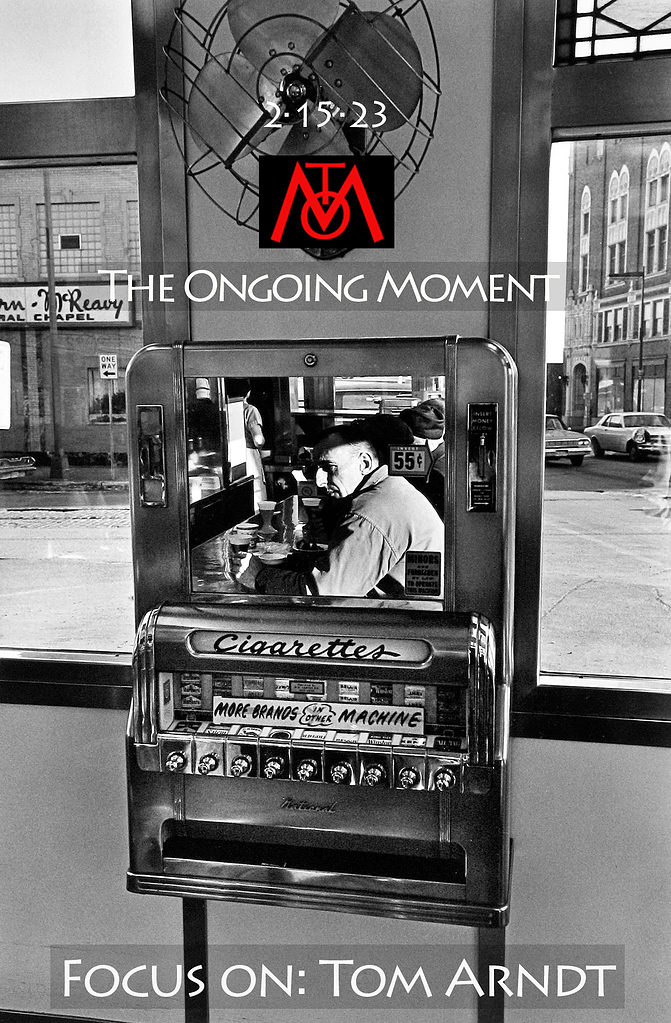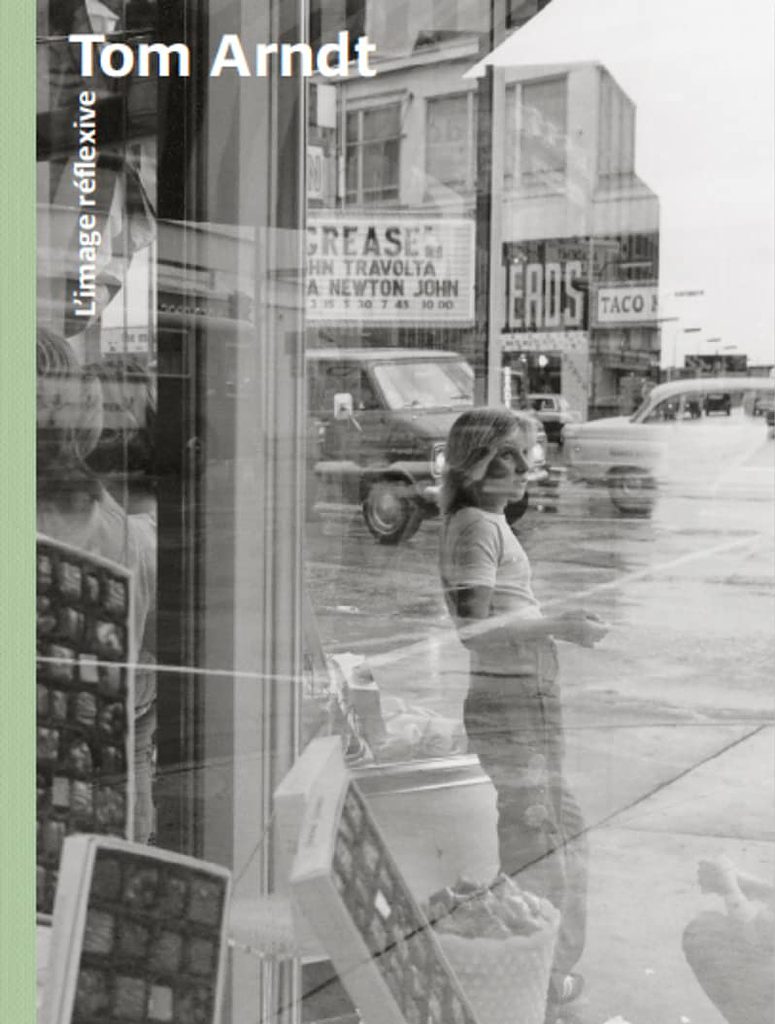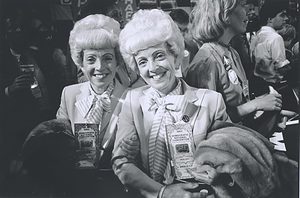
Born in Minneapolis in 1944, Tom Arndt’s photography belongs to the grand, classic tradition of American documentary photography. Arndt’s work includes sensitive, empathetic portrayals of everyday citizens, in their coffee shops and soda fountains, their streets, their shop windows, their parks, at popular state fairs. Pessimism and pity are out of place. As Arndt’s friend and well known writer Garrison Keillor points out, Tom Arndt photographs the DNA of our culture. A consistently resourceful street photographer, Arndt captures fleeting gestures and momentary juxtapositions between people and their surroundings, finding in them a sense of emotional or psychological depth.
Arndt received a BFA from the Minneapolis College of Art and Design (1968) and did graduate study at the University of Minnesota (1969-1971). His photographs have been exhibited at the Walker Art Center, Minneapolis; the Museum of Modern Art, New York; Minneapolis Institute of Art; Minneapolis College of Art and Design, and other venues. His work is held in the permanent collections of the Art Institute of Chicago; Museum of Modern Art, New York; San Francisco Museum of Modern Art; George Eastman House, Rochester, New York; Los Angeles County Museum of Art; and Walker Art Center, Minneapolis.
We are honored to have Tom reflect on his journey to Photo Paris 2022 and release of his new book American Reflections. I am sure it will be both educational and inspirational.
An autographed copy of Tom’s book Home will be given away during the gathering

Tom Arndt: American Reflections
For this monograph, Tom Arndt, one of the masters of documentary photography, opened his archives. Over a hundred images, half a century of American history (from 1970 to 2015) is told in a wandering led like a road-movie. Each photograph tells a story. Under a sociological and empathetic gaze, Tom Arndt captures fragments of the lives of women and men from the middle class, the agricultural world, the dreary suburbs or the hectic streets of the great metropolises of New York, Chicago, Los Angeles or still his hometown, Minneapolis.
The illuminated signs, the reflections in the windows (themes that run through all of the photographer’s work), the silhouettes taken from life, are all details that structure the photographic image. Lights and architectural lines compose powerful images, icons of a timeless America.
Since the mid-1960s, Tom Arndt has been the most vital force representing the photographic consciousness and innovation of Minneapolis. (…) His photographs of the city have contributed to the genre of street photography, an integral part of the history of photography. (…) As a young photographer Arndt experienced one of the most turbulent periods in postwar American history.
In July 1967, triggered by decades of police brutality against African Americans in the North Minneapolis communities, the Minneapolis riot had erupted amid the nation-wide Civil Rights Movement. Arndt used (and still uses) Leica rangefinder cameras, to document the city’s streets during this transformative period. Subsequently pursuing graduate studies in photography at the University of Minnesota, Twin Cities, Arndt further developed his skills with influential photographers and filmmakers who embraced conceptual documentary practice, such as Jerome Liebling, Elaine Mayes, and Allen Downs.
He was exposed to photographs by Minor White, Gordon Parks, Esther Bubley, and John Vachon. Robert Frank, Yasuhiro Ishimoto, and Bill Brandt, among many others, also had an impact on the young Arndt. Arndt benefited greatly from the robust development of Mia’s photography collection and exhibition program, directed by the museum’s first Curator of Photographs, Ted Hartwell, whom Arndt met during the second year of his graduate studies. The museum’s strong photographic program blossomed thanks to Hartwell’s ambition, supported by the city’s philanthropic community and initially by the curator’s friendship with John Szarkowski, the director and curator of photography at the Museum of Modern Art in New York from 1962 to 1991.
(Originally from Wisconsin, Szarkowski had worked as a staff photographer at the Walker Arts Center in Minneapolis before joining MoMA.) Szarkowski, who shared with Arndt a passion to make photographs about Minnesota, played an instrumental role in acquiring his work in the early 1980s for the MoMA collection. Arndt’s complex images of Minneapolis often reveal a store window with kaleidoscopic views of the city’s urban and built environments and passersby, including Arndt himself. He also made cars and trucks—an important means of transportation in the everyday life of the state, whether parked or on the urban and suburban streets—a subject of his pictorial observation. Also taken in the city, the photograph titled 4th of July, Minneapolis, 1976 is a different kind of image of the city. There, Arndt photographed three fashionably dressed black youths (sporting Afros, bell-bottom jeans, and platform shoes) seated on the grass, relaxing while they wait for the Fourth of July celebrations in Powderhorn Park in southern Minneapolis. Arndt grew up in this area and he frequented the park—which is also within a mile of George Floyd Square—and knew the neighborhood well. Most of those he photographed were aware of him and he often engaged in conversation with them. For Arndt it is important that the people he photographs feel comfortable, an outlook that tends to produce intimacy between him and his subjects. Thirty-six years later, in the spring and summer of 2020, Arndt traced the devastation of Minneapolis following the murder of George Floyd on May 27, 2020, in southern Minneapolis, a neighborhood the photographer grew up in and knew well.
(Yasufumi Nakamori Extracts from “Tom Arndt and Minneapolis”, published in Tom Arndt: American Reflections, Atelier EXB, 2O22)
About the Author
Born in Minneapolis, Tom Arndt’s photography focuses on his native Minnesota. Belonging to the grand, classic tradition of American documentary photography, Tom Arndt’s body of work offers us a sensitive, empathetic portrayal: a family album of the people who live in his state including their coffee shops and soda fountains, their streets, their shop windows, their parks, the popular state fairs. Pessimism and pity are out of place here. As Arndt’s friend and well known writer Garrison Keillor points out, Tom Arndt photographs the DNA of Minnesotan culture: the poor and the left out.
Tom Arndt belongs to the silver print processing tradition; his printing is exceptionally beautiful. He spends at least several hours daily in the darkroom; he really loves the paper print. Arndt received a BFA from the Minneapolis College of Art and Design (1968) and did graduate study at the University of Minnesota (1969-1971). His photographs have been exhibited at the Walker Art Center, Minneapolis; the Museum of Modern Art, New York; Minneapolis Institute of Art; Minneapolis College of Art and Design, and other venues. His work is held in the permanent collections of the Art Institute of Chicago; Museum of Modern Art, New York; San Francisco Museum of Modern Art; George Eastman House, Rochester, New York; Los Angeles County Museum of Art; and Walker Art Center, Minneapolis.
Tom Arndt: American Reflections
FROM NOVEMBER 4, 2022 TO JANUARY 21, 2023
Les Douches la Galerie – Paris- France
Links
Where I Live,” an exhibition of photos by Tom Arndt
Exibart Street
Howard Greenberg
The Eye of Photograpny

